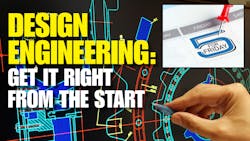5 for Friday: Reigniting Design’s Value; New Dimensions in CAD-Related Software and Additive Manufacturing
1. Reigniting the Value of Design
Machine Design has been around for more than 90 years, and helping understand and highlight effective design techniques is part of our DNA. Even so, we’ve seen design’s value grow in recent years to impact everything from productivity to sustainability. As manufacturers of all kinds take a fresh look at design as a function of process improvement, as well as of operational efficiency and profitability, Machine Design has developed a new eBook that focuses on how new technologies and old design principles are combining to create a better designed world every day.
Among the topics:
- DfX: How Design for Excellence Guides Product Development
- Five Emerging Technology Trends ASME is Following
- Don’t Overlook Planning: 5 Ways to Get Growth Right at the Start
To review this highly valuable guide to modern design fundamentals, click here to visit our Member’s Only page and download the eBook for free.
2. A New Era in CAD
The concept of Design for Additive Manufacturing (DfAM) is another discipline gaining momentum. A new Machine Design article interviews Dr. Elissa Ross, co-founder and CEO of Metafold. She offers a number of interesting insights, including how she sees the way CAD and additive manufacturing have continued to evolve:
“[CAD systems] were developed for conventional manufacturing, and they are excellent in those capacities,” Ross said. “But when it comes to supporting high complexity, geometry—that is…what 3D printing is really great at—those same digital tools are traditional CAD tools. They don’t offer what we need.”
3. Another Dimension of Additive
The combination of CAD or SolidWorks with other software applications is catching on in some interesting new markets. Sporting goods, for example. Sharon Spielman, technical editor of Machine Design, spoke with Glen Mason of baseball bat manufacturer DeMarini, a division of Wilson Sporting Goods, and Lasse Staal, business development director of Nexa3D, to look at how advanced design software improves the sports equipment of tomorrow.
In part of that discussion, Staal notes that allowing manufacturers to use existing equipment instead of having to invest in entirely new software or equipment is a game-changer.
“To get this to work, you don’t have to buy a new injection molding machine or a new material for that matter,” Staal says. “You can use what’s already there. And that’s also part of the sustainability. We shouldn’t try to replace stuff that already works; we should try to enhance it.”
4. 5 Steps to Successful AMR Deployment
Autonomous mobile robots only get autonomous after you tell them what to do. And their deployment only is successful after you agree as a team what those activities should be. The key to a successful AMR deployment, as Brian Betts notes in a new Machine Design article, is to systematically approach the questions from the solution first. This five-step process will help bring clarity and focus to the problems and precision to the solution. Only then can the AMR perform its functions with the kind of precision that you’d expect.
5. Testing for Reliability
Every product starts off with the expectation of being reliable when deployed, but that expectation has to be designed into the product at the start. One way to assure this, as a new Machine Design article notes, is Reliability Demonstration Testing (RDT). It has been widely used in the manufacturing industry to verify whether a product has met a certain reliability requirement with a stated confidence level. This is a pass/fail test that is usually performed at a system or product level. The RDT process can be divided into three stages: planning, testing and monitoring and data analysis.
About the Author

Bob Vavra
Editor Emeritus, Machine Design and Power & Motion
Bob Vavra is the former senior content director of Machine Design and Power & Motion.
